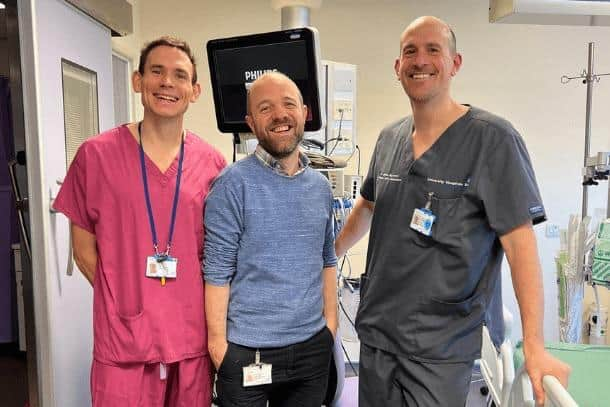UHSussex colleagues' emergency airway management study published in top anaesthesia journal
and live on Freeview channel 276
When a patient has trouble breathing – whether it’s from injury or inflammation to the airway or something blocking it – it is a medical emergency that needs immediate attention.
This is called emergency airway management and critical care colleagues from UHSussex have conducted a study that will help improve our understanding about best practice.
Advertisement
Hide AdAdvertisement
Hide AdDr Jamie Gibson and Dr Todd Leckie, Anaesthetics and Intensive Care Medicine Trainees and Dr James Hayward and Dr Luke Hodgson, Intensive Care Consultants from University Hospitals Sussex NHS Foundation Trust, have explored the current UK practice for emergency airway management that happens outside of the operating theatre environment and assessed the results, which have been published in a research journal.


Airway management is vital to emergency medicine and is a procedure that involves maintaining or restoring a person’s breathing.
Emergency airway management isn’t just performed within operating theatres but can happen across hospitals in areas such as emergency departments and intensive care units (ICU).
When it happens outside of theatres, previous research showed these events disproportionately led to complications in comparison to when they happened in an operating theatre environment and were performed by more experienced clinicians.
Advertisement
Hide AdAdvertisement
Hide AdDespite such events happening frequently, few studies have reported on the occurrence of these events and explained how they are managed.
Dr Todd Leckie said: “Emergency airway management outside of the theatre environment is well known to represent a potentially high-risk situation and is often performed by trainee anaesthetists out of hours.
“Other trainees have carried out similar observational studies which gave us the confidence to deliver our own multi-centre study, to provide a comprehensive summary of emergency airway management.”
Todd, Luke, James and Jamie partnered with South East Anaesthetic Research Chain (SEARCH), to examine events of non-theatre emergency airway management across nine acute NHS hospitals.
Advertisement
Hide AdAdvertisement
Hide AdDoctors working in anaesthetics and intensive care were encouraged to fill out a form when they looked after patients who needed support with their airway. This data was collected to try and identify any patterns or themes that were emerging in how these events were handled and establish how practice could be improved.
Events investigated included simple airway techniques which are non-invasive and advanced airway techniques which are invasive and require specialised medical equipment including intubation and cardiac arrests. Cases involving children were also included and this work has since been published in the same journal.
Dr Luke Hodgson said: “We found that there was significant variation in some elements of airway management, although in many areas management was consistent with best practice. This study provides us with important information to understand how we can further improve our clinical management of patients requiring emergency airway support.”
One of their main findings was a significant increase in the use of technology to manage a patient’s airway in these events.
Advertisement
Hide AdAdvertisement
Hide AdIn the past, a direct laryngoscope, which is a thin telescope that looks into the patient’s throat to give a direct view of their airway, would typically be used.
This study suggested that when a video laryngoscope was used instead – clinicians had an improved, high resolution visual of the airway which reduced the risk of complications and errors.
The pair are now in conversations with colleagues throughout the country who are keen for this to become a national study that investigates this subject even more closely with a wider number of patients and have applied for a grant to help deliver this.